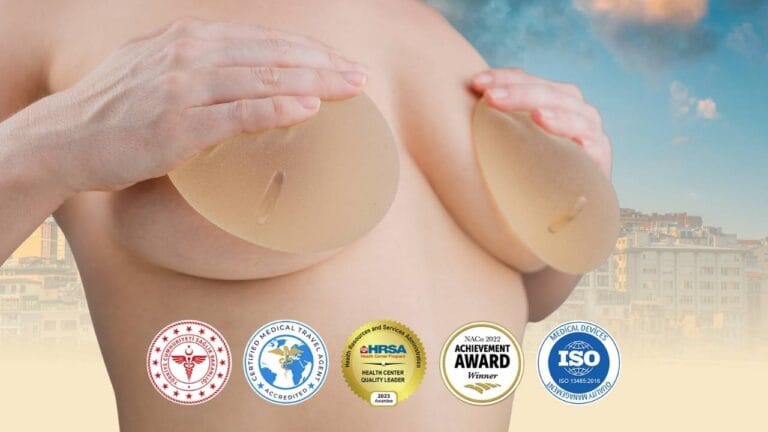Understanding the Breast Implant “Drop and Fluff” Timeline is essential for managing anxiety after breast augmentation. The process of settling is normal, but requires significant patience. This guide explains the realistic journey of high, firm implants becoming soft and natural.
What are “Drop” and “Fluff”?
The term “Drop and Fluff” describes the natural and necessary physiological changes that occur as your body heals around the implant. This process happens when the tissue pocket created by the surgeon finally stretches to accommodate the implant, allowing it to settle into its final, lower, and more natural position.
- Drop: This is the gravity-assisted descent of the implant from its initial high, tight position into the lower breast fold. This is the structural correction.
- Fluff: This is the softening and expansion of the tissue in the lower breast pole. As the skin stretches, the lower breast tissue fills out (“fluffs”), making the implant feel softer and look less round or “fake.”
Patience is the single most important factor in the success of this phase.
Clinic Care Center: Expert Warning (Normal vs. Complication)
The early ‘high’ and ‘hard’ appearance is normal. But not all hardness is normal. If your implant remains hard, painful, or moves upward after the 6-month mark, it is NOT ‘fluffing’; it could be Capsular Contracture (hardening of the scar tissue around the implant), which requires immediate medical evaluation and may necessitate revision surgery. Normal ‘fluffing’ is the softening of the tissue around the implant.
Breast Implant Healing Timeline: The “Drop and Fluff” Stages
The majority of the settling occurs in the first six months, but the final texture takes longer.
| Time Period | What the Patient Sees & Feels (Reality) |
|---|---|
| Week 1-3 | Implants are high, tight, and look “fake.” Maximum swelling and bruising. |
| Month 1-3 | The implant begins the active “drop” (settling). The lower pole starts to “fluff” as the skin stretches. |
| Month 3-6 | The most active ‘fluffing’ phase. Implants look much more natural, softer, and less hard. The final size is almost reached. |
| Month 6-12 | The final shape fully settles. All residual minor swelling resolves. Scars mature. |
| Year 1+ | Final Result. Texture and softness are fully complete. |
Potential Risks & Realistic Expectations
We must be transparent: there is no ‘guaranteed’ outcome or ‘risk-free’ surgery. The primary risk during this phase is the potential for Capsular Contracture (hardening of the scar tissue). Other complications include bottoming out (implant drops too low) or symmastia (implants touch in the middle). We cannot ‘guarantee’ a specific cup size or softness. The realistic expectation is that patience (12 months) is mandatory and that the final result will be a natural-looking improvement, not a quick, miracle fix.
Frequently Asked Questions (FAQ)
How long does the drop and fluff process take?
The main drop and fluff process usually takes 3 to 6 months, but final tissue settling continues up to 12 months.
Why are my implants so hard and high after surgery?
They are high and hard due to post-surgical swelling and the natural tightness of the breast pocket before the skin stretches.
What is the difference between ‘fluffing’ and capsular contracture?
‘Fluffing’ is the normal *softening* of tissue; capsular contracture is the *hardening* of scar tissue around the implant, which is a complication.
Will my implants get softer after 6 months?
Yes, implants continue to soften significantly between the 6 and 12-month marks as residual swelling entirely resolves.
What is bottoming out?
Bottoming out is a complication where the implant drops *too low*, stretching the inframammary fold and causing the nipple to look high.
How can I help my implants drop and fluff faster?
Following your surgeon’s specific post-op instructions regarding pocket massage and avoiding heavy lifting is the only way to help the process.
Is it normal to have nipple pain 3 months after breast augmentation?
Mild, intermittent nipple pain or numbness is normal up to 6 months, as the nerves are still regenerating.
Does implant size affect the drop and fluff timeline?
Yes, larger implants generally require a longer period (closer to 6 months) for the pocket to stretch and the implant to fully drop and fluff.
Worried About Your Implants? Get Peace of Mind.
The recovery process requires patience. If you are anxious that your ‘fluff’ isn’t progressing normally, the experts at Clinic Care Center can provide an honest evaluation. Contact us today for a consultation and reassurance on your healing timeline.
Also Read:
Breast Augmentation
Breast Lifting
Breast Reduction
Breast Implant Removal


